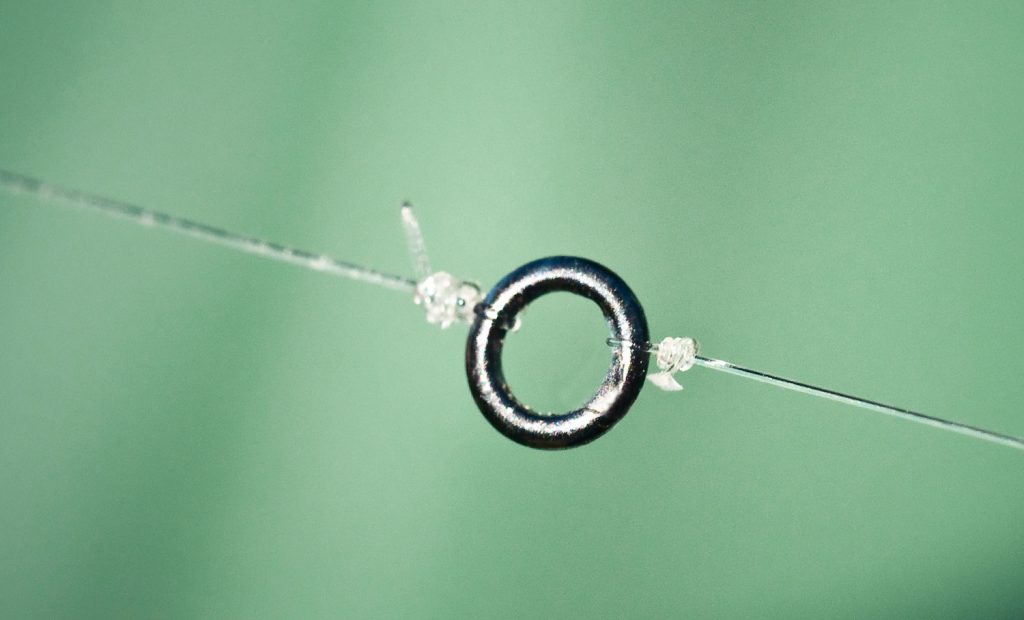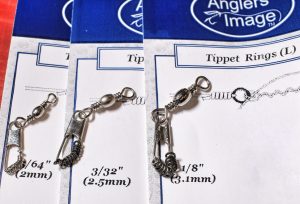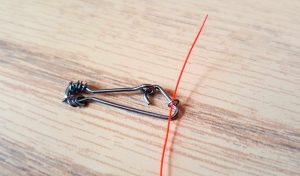 Over the last few years, tippet rings have been gaining more and more popularity and acceptance. Most new fly fishermen love them. Most traditionalists hate them. What are they?
Over the last few years, tippet rings have been gaining more and more popularity and acceptance. Most new fly fishermen love them. Most traditionalists hate them. What are they?
In case you’re new to the sport, lets start with a quick overview of leaders. The leader is simply the monofilament connection between the the heavier fly line and the actual fly. Typically 7 1/2′ to 12′ in total length, leaders are tapered from a thick butt section that attaches to the fly line to a finer tippet section that attaches to the fly. Check out this link for more detailed info on leaders and tippet.
As you change flies (or lose them in trees), your tippet gets gradually shorter until it is no longer the proper length, or worse, you’ve cut it away to the point that you’re in the thicker part of the leader. In this situation, you would cut a length of tippet from the appropriate size spool of tippet material, tie it to the existing leader, and ultimately rebuild your leader back to its original length and size.
Though tying the knot to splice the new piece of tippet back to the leader is not very complicated with a little practice, many anglers struggle with it, or don’t want to take the time to learn it. For these fishermen, the tippet ring is like an answered prayer!

Tippet rings are very small metal rings, available in a few different sizes, that simplify this splice. You tie it to the end of your leader using whatever knot you prefer for tying on a fly. Then you tie a piece of tippet to the ring using that same knot. You could also tie a second piece of tippet off the ring to add a second fly for a dropper rig. So, all of your frequent connections can be made using the same knot.

This is one of the biggest benefits to using tippet rings. It just simplifies the process, particularly for someone who may not fish frequently and may have trouble remembering or executing various knots. Another benefit is that they can greatly prolong the life of your overall leader since your always replacing tippet off the ring and not cutting part of your leader away every time you change tippet.
Of course, there are also down sides – at least in my opinion. First, I don’t think it makes as strong of a connection as when you splice using more traditional Surgeons or Blood Knots. This may not make much difference on smaller fish, but I believe you have a much better chance of breaking off a big fish if you’re using a tippet ring. Second, the tippet ring creates a “dead spot” in the leader which can negatively impact you in a couple of ways.
One way is with straight line nymphing. This technique is commonly used in mountain streams and requires a certain amount of feel. With that tippet ring creating a dead spot between leader and tippet, I believe you’re more likely to miss some of the more subtle takes of a trout. That dead spot also can create problems with accuracy.
One of the main functions of a tapered leader is to transfer energy during a cast. It’s what helps prevent things like hard splash downs or tippet pile-up on a cast. When you put a tippet ring in the middle of all of that, the dead spot created can act almost like a short in an electrical current. The energy doesn’t transfer smoothly from the taper of the leader to the tippet and can create a hinging effect – resulting in a significant loss of accuracy.
Like most things, you have to consider the kind of fishing you do and how important things like feel or accuracy are to you. For me, they’re pretty important. For others, they may take a backseat to convenience. And that’s okay! Figure out your system and roll with it!
